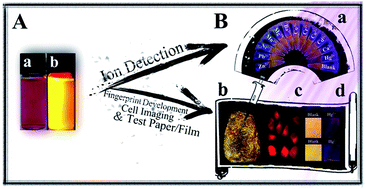Facile synthesis of orange emissive carbon dots and their application for mercury ion detection and fast fingerprint development†
Abstract
In this paper, orange emitting carbon dots (CDs) were synthesized by a hydrothermal process, exhibiting emission at 574 nm when excited at 555 nm, with a fluorescence quantum efficiency of 46%. The fluorescence of the CDs as the fluorescent probe were quenched by Hg2+ with the limit of detection of 2.47 nM in ultrapure water. Besides, practical applications of the probe, i.e., for the detection of Hg2+ in lake, river and sea water samples have been carried out. Owing to the rapid detection ability, a test paper and a cellulose acetate film were prepared and effectively used in Hg2+ detection, thus extending the application in many practical areas. The CDs can also be used to visualize the latent fingerprints (LFPs) at a high speed. After 10 s of immersion in the CD solution, the second level details of the LFPs could be clearly developed and showed up under UV light. The CDs performed well in visualizing aged LFP development, as the secondary characteristic result of the 120 day sample was still good. Studies on some specific substrates such as curved surfaces, multicolored surfaces and blue fluorescence backgrounds all showed good results. Additionally, the good HepG-2 cell imaging and MTT assay prove the biocompatibility and low toxicity of the as-prepared CDs.



 Please wait while we load your content...
Please wait while we load your content...